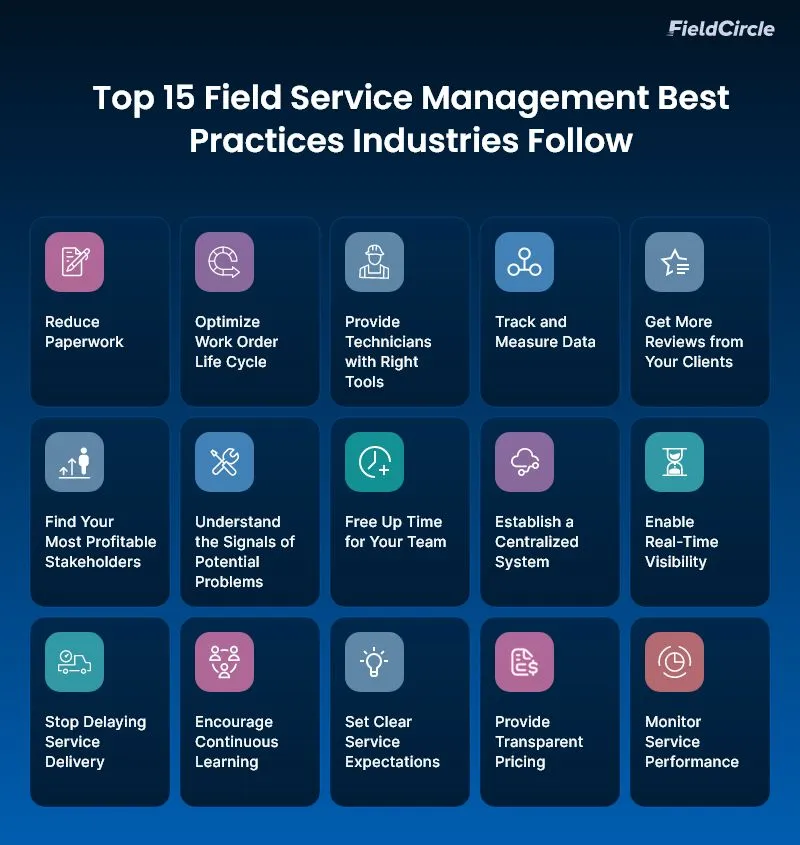Top 15 Field Service Management Best Practices Industries Follow in 2025

In sectors like healthcare, property maintenance, construction, telecommunications, and other fields involving remote services, installations, and off-site operations, it’s essential to have a well-designed and comprehensive field service plan along with efficient data collection software. According to Fortune Business Insights, the Field Service Management (FSM) market is projected to expand to 8.06 million by 2028, up from USD 3.24 million in 2021, with a 13.9% CAGR from 2021 to 2028. In today’s business landscape, successful companies cannot overlook the importance of meticulously cataloging and potentially analyzing every detail of the services they provide, particularly those conducted off-site
Technologies such as the Cloud, mobility, IoT, and AR and VR are revolutionizing field operations, making them more efficient and error-proof compared to traditional paper-based methods. When these technologies are seamlessly integrated into everyday processes, they amplify the capabilities of field technicians and elevate the customer experience.
Optimizing field service management is an opportunity to leverage cutting-edge technologies and innovative strategies to enhance Field Service operations. As organizations navigate the complexities of environmental and safety compliance, adopting best practices ensures streamlined operations and stakeholder satisfaction.
Here are 15 best practices in field service management that enable organizations to optimize their operational efficiency and deliver superior service in off-site management. These practices promise not only to address the challenges in field service but also to harness the potential of modern technology for remarkable improvements in field service operations. They are essential to remain competitive in the field service industry. Let’s see how each one of them adds value to and elevates the performance of your business.
15 Field Service Management Best Practices
There are many factors to consider when optimizing on-location operations. To get started, here are some key areas to focus on:
1. Reduce Paperwork
Implementing a field service management solution is crucial for businesses aiming to streamline their operations. By digitizing processes such as work orders, invoices, and customer data, this solution eliminates the need for cumbersome paperwork, reducing errors and enhancing overall efficiency. With all information centralized in a digital format, businesses can easily track field technicians, manage customer interactions, and coordinate work orders seamlessly, leading to smoother operations and improved productivity.
Paperwork poses a significant challenge for many businesses, particularly in off-site operations where technicians frequently operate in remote areas with limited access to traditional office equipment like printers and scanners. To overcome this challenge, numerous companies are opting to eliminate paper entirely.
Instead, they employ field service mobile apps to manage work orders, invoices, and other essential documents. This shift enables technicians to access required information conveniently without the burden of carrying physical paperwork. Moreover, utilizing such apps streamlines managerial oversight by facilitating real-time tracking of work progress and ensuring the accuracy and currency of all documentation.
2. Optimize Work Order Life Cycle
To optimize field service operations, it is essential to focus on specific areas that directly impact the efficiency and success of the field service business. By streamlining processes from the creation to the completion of work orders, businesses can ensure faster service delivery and better resource utilization. Through the implementation of automated workflows, scheduling algorithms, and efficient route planning, tasks can be prioritized effectively, technicians can be assigned tasks that match their skill sets, and travel time can be minimized, ultimately maximizing productivity.
It is imperative to streamline this workflow as much as possible to enhance service efficiency. Leveraging mobile applications can greatly aid in this endeavor by offering a centralized platform for managing all work orders and providing a unified view of all field activities.
Additionally, it is essential to establish realistic expectations for both customers and technicians. For instance, providing estimated arrival times (ETA) for each job enables customers to anticipate the technician’s arrival and plan their schedules accordingly. Similarly, technicians can use this information to plan their routes effectively, ensuring timely arrivals at each service location.
3. Provide Technicians with Right Tools and Right Information
Equipping technicians with the necessary tools, equipment, and access to relevant information is crucial for ensuring efficient field service operations. By providing technicians with mobile devices loaded with troubleshooting guides, manuals, and access to a centralized knowledge base, they can efficiently address issues on-site without the need to return to the office or consult multiple resources. This empowers technicians to resolve problems quickly and effectively, leading to improved customer satisfaction and service quality.
Moreover, ensuring technicians have seamless access to pertinent information during their assignments is vital. This can be facilitated through mobile applications equipped with searchable databases containing technical documentation.
4. Track and Measure Data
Tracking and measuring data on key performance metrics is essential for businesses to identify areas for improvement and make data-driven decisions. This step is essential to sustain the field service performance even in tough times. By collecting data on metrics such as response times, first-time fix rates, and customer satisfaction scores, businesses can gain insights into operational efficiency and identify trends or recurring issues that require attention. This allows for proactive adjustments to processes and workflows, ultimately leading to improved performance and customer satisfaction.
Field management applications serve as indispensable tools for tracking and evaluating data. However, selecting the most suitable one is imperative, alongside guaranteeing universal access to pertinent information for all service technicians. Employing a mobile application equipped with data analytics functionalities and a comprehensive dashboard is indispensable for translating data into interactive charts and statistics.
Adhering to these best practices in field service management holds the potential to streamline operations and elevate service proficiency.
5. Get More Reviews from Your Clients
Encouraging and obtaining feedback from clients is crucial for businesses to gauge satisfaction levels and identify opportunities for improvement. By implementing mechanisms such as post-service surveys, review requests, or feedback forms, businesses can gather valuable insights into the customer experience. Positive reviews can enhance the company’s reputation and attract more clients, while constructive feedback can pinpoint areas needing attention, allowing for adjustments to service delivery processes and ultimately leading to improved customer satisfaction and loyalty.
6. Find Your Most Profitable Customers and Technicians
Analyzing customer and technician performance data is essential for businesses to identify high-value clients and top-performing technicians. Businesses can allocate resources more effectively by evaluating metrics such as customer lifetime value, service profitability, and technician productivity. Targeted marketing efforts can be directed towards profitable customers, while incentives and recognition can be provided to top-performing technicians, fostering loyalty and improving overall business performance.
7. Understand the Signals of Potential Equipment Problems
Proactively monitoring equipment performance and identifying potential issues is critical for preventing costly breakdowns and minimizing downtime. By leveraging technologies such as IoT sensors and predictive maintenance algorithms, businesses can detect anomalies or abnormalities in equipment operations in real-time. This allows for timely intervention and preventive maintenance measures to be implemented, ensuring equipment reliability and uninterrupted service delivery, enhancing customer satisfaction, and fostering trust and loyalty in the long run.
Anticipating equipment failures enables proactive measures to be taken. By recognizing patterns and indicators signaling impending issues, maintenance activities can be scheduled strategically. This proactive approach diminishes the likelihood of costly breakdowns and minimizes unplanned downtime, thereby enhancing operational efficiency and boosting productivity.
Furthermore, addressing issues in their embryonic stages prevents their escalation into major problems. Intervening before a failure occurs saves considerable costs associated with emergency repairs or premature equipment replacements. This optimization of maintenance activities fosters a more streamlined and cost-effective operation.
8. Free Up Time for Your Team
Automating repetitive tasks and optimizing workflows is essential for maximizing efficiency and productivity. Businesses can reduce the workload on field service teams by implementing self-service portals for tasks such as appointment scheduling or accessing FAQs. This frees up time for technicians to focus on higher-value activities, such as complex repairs or proactive maintenance, ultimately improving service quality and customer satisfaction.
With readily accessible self-help resources such as step-by-step guides, FAQs, and instructional videos, customers can autonomously address common issues. This empowerment reduces the need for service calls, thereby liberating valuable time for service teams to concentrate on critical tasks.
The streamlined approach facilitated by self-service options elevates operational efficiency and augments customer satisfaction. Businesses foster loyalty and contentment by providing customers with instant access to solutions and affording them greater control over their service experience.
9. Establish a Centralized System
Centralizing data and processes in a unified system is crucial for ensuring seamless communication and collaboration across departments. Businesses can consolidate customer data, work orders, scheduling, and billing by implementing an integrated field service management platform. This eliminates silos, reduces duplicate data entry, and enhances overall visibility and coordination. With all information accessible from a centralized system, businesses can streamline operations, improve decision-making, and deliver consistent and efficient service to customers.
In the absence of a centralized system, field operations may lack organization, leading to inefficient assignment procedures. Without a central platform, schedulers and dispatchers might encounter difficulties accessing real-time information regarding technician availability, skills, and workload, consequently causing inaccuracies and delays in assignments.
Integrating field management software establishes a centralized system that optimizes assignment procedures. This software empowers schedulers and dispatchers to effortlessly oversee and manage technician availability, skill sets, and workload.
Consolidating all essential information in one location notably enhances assignment precision. Additionally, the centralized system facilitates effective communication and collaboration among most important stakeholders, minimizing errors and ensuring assignments are completed promptly.
10. Enable Real-Time Visibility
Providing real-time visibility into field operations is essential for tracking job progress, technician locations, and responding promptly to changes or emergencies. By leveraging technologies such as GPS tracking and mobile applications, businesses can monitor technician whereabouts in real-time. This enables efficient dispatching of service requests to the nearest available technician and provides customers with accurate arrival times. Real-time visibility enhances transparency, increases operational efficiency, and improves customer satisfaction.
11. Stop Delaying Service Delivery
Minimizing response times and reducing service delays is critical for meeting customer expectations and maintaining satisfaction. By implementing automated scheduling and dispatching algorithms, businesses can ensure that service requests are promptly assigned to available technicians based on factors such as proximity and workload. This reduces wait times for customers, increases service efficiency, and improves overall service delivery.
12. Equip Technicians with Continuous Learning
Providing ongoing training and access to educational resources is essential for keeping technicians updated on new technologies and best practices. By offering online training modules, workshops, and certification programs, businesses can empower technicians to acquire new skills and stay informed about industry trends. Continuous learning enhances technicians’ problem-solving abilities, improves service quality, and ultimately contributes to customer satisfaction and loyalty.
13. Set Clear Service Expectations
Establishing clear service level agreements (SLAs) and communicating expectations upfront is vital for managing customer expectations and ensuring service delivery meets agreed-upon standards. Businesses can minimize misunderstandings and disputes by clearly outlining response times, service windows, and resolution timelines in service contracts or agreements. Clear service expectations enhance customer satisfaction, build trust, and strengthen customer relationships.
14. Provide Transparent Pricing
Transparency in pricing and billing practices is essential for building trust and confidence with customers. By providing detailed quotes or estimates upfront, including itemized breakdowns of labor, parts, and other charges, businesses can ensure transparency and avoid surprises when presenting the final invoice. Transparent pricing allows customers to make informed decisions and fosters trust, leading to improved customer satisfaction and loyalty.
15. Continuously Monitor Service Performance
Regularly monitoring service performance metrics and soliciting feedback from customers and technicians allows businesses to identify areas for improvement and make timely adjustments. By conducting regular performance reviews, analyzing customer satisfaction scores, and holding feedback sessions with technicians, businesses can identify trends, address recurring issues, and implement corrective actions. Continuous monitoring of service performance ensures ongoing optimization of service quality and efficiency, ultimately leading to enhanced customer satisfaction and retention.


